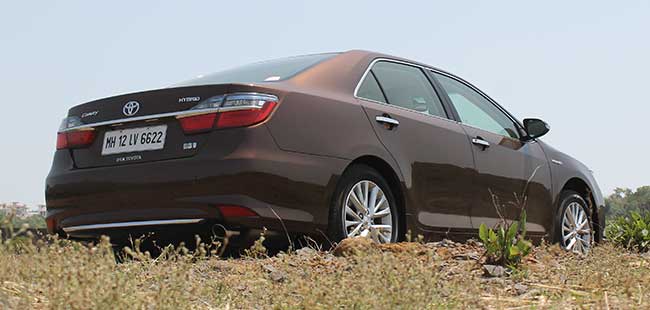Review: Toyota Camry Hybrid Facelift

Highlights
The Camry was first brought to India in 2002 and since then Toyota has sold 8000 units till date. When I asked how much it sold last year, the prompt answer was around 700 odd units. The surprising bit though was that 73% (532 units) of the cars sold were hybrids while the rest were the conventional petrol lot. The fact that there are more hybrids sold in India, shows that there is a market and that seems to justify why Toyota has brought the facelift of the 7th generation of the Camry to India.
So what is this facelift all about? Well, Toyota has given the new Camry a whole bunch of exterior changes. These include a slimmer front grill and sleek looking headlamps, so it's not at all boring now and looks pretty good. Toyota has also given the Camry LED daytime running lights, while also giving LED main lamps. There is a bit of a bulge on top of the bonnet which gives the front a bit of character, while the massive trapezoidal air dam at the front brings out the wild side of the car. There are changes to the rear as well and overall, the facelift does wonders to the look of the Camry.

However, I have to admit that there's a lot of chrome; probably an overdose of it. The chrome strips run around the chin at the front, the air dam, the door handles, the window sills, the rear and even the tip of the rear bumper. It's all in the name of making it look up market but well, there's a lot.
As we move to the inside of the car, there is a bit of familiarity. There's a lot picked up from the pre-facelift version but none of it feels old fashioned. The centre console is U-shaped and the there's also a new colour information display in the centre of the instrument panel. Thanks to the 3-zone automatic Climate control, the rear seat, as on the previous car, gets its own temperature setting. In fact, the rear seat backs recline up to eight degrees, and is a place to be pampered in.

There have been a whole bunch of changes made to the exterior of the car, but under the hood is the same old affair. Toyota's DOHC VVT-i 2.5-litre petrol unit and the electric motor work together to churn out 202bhp - 158bhp from the petrol motor, and 44bhp from the electric motor. The power split device helps to deliver seamless power to the wheels, and also to the generator that keeps on charging the battery. The battery is nickel metal hydride, unlike the usual lithium-ion, and is placed inside the boot.
There are two driving modes to choose from - EV and Eco. The EV mode kicks in if you're stuck in traffic, as it doesn't allow you to go above 40km/h. If you switch to Eco mode where the electric motor and the petrol engine work hand-in-hand with one another, the hybrid systems jigsaw is solved. The result is that you're immediately transported into an evolved and refined driving experience, not to forget an efficient one.
Then there's the e-CVT (electronically continuously variable transmission), which the engine is mated to and when you floor the accelerator, the revs build up and though delayed, the power delivery is seamless. The torquey petrol engine takes off its gloves and provides immense energy, which truly builds your excitement levels. The ride quality too is refined and Toyota says that they have re-tuned the shock absorbers to help the Camry eat up the bumps on the road. Efficiency wise, Toyota claims that the Camry Hybrid delivers 19.6km/l (ARAI figures), which is truly impressive for a car of this size.
Now, we come down to the price of the car and at Rs. 31.92 lakhs (ex-showroom Delhi) it is pretty steep. In fact it treads on the territory of the luxury car makers like Audi, Mercedes and BMW. This might be a worrying factor for Toyota but the ace up their sleeve is the hybrid system in the car and thanks to the FAME-India scheme (Faster Adoption and Manufacturing of Electric vehicles in India), recently introduced by the Indian government, it will receive a relief of Rs. 70,000 which the car maker will pass on to the customer. Yes, it's expensive but that's the price you pay for luxury, innovations and fuel-saving technology.
Last Updated on September 11, 2015
Related Articles
Latest Reviews
Popular Toyota Models
 Toyota FortunerEx-Showroom Price₹ 33.43 - 51.44 Lakh
Toyota FortunerEx-Showroom Price₹ 33.43 - 51.44 Lakh Toyota Innova CrystaEx-Showroom Price₹ 19.13 - 26.3 Lakh
Toyota Innova CrystaEx-Showroom Price₹ 19.13 - 26.3 Lakh Toyota RumionEx-Showroom Price₹ 10.44 - 13.73 Lakh
Toyota RumionEx-Showroom Price₹ 10.44 - 13.73 Lakh Toyota Urban Cruiser TaisorEx-Showroom Price₹ 7.74 - 13.04 Lakh
Toyota Urban Cruiser TaisorEx-Showroom Price₹ 7.74 - 13.04 Lakh Toyota Land CruiserEx-Showroom Price₹ 2.31 - 2.41 Crore
Toyota Land CruiserEx-Showroom Price₹ 2.31 - 2.41 Crore Toyota Urban Cruiser HyryderEx-Showroom Price₹ 11.14 - 20.19 Lakh
Toyota Urban Cruiser HyryderEx-Showroom Price₹ 11.14 - 20.19 Lakh Toyota Innova HycrossEx-Showroom Price₹ 19.09 - 31.34 Lakh
Toyota Innova HycrossEx-Showroom Price₹ 19.09 - 31.34 Lakh Toyota CamryEx-Showroom Price₹ 48 Lakh
Toyota CamryEx-Showroom Price₹ 48 Lakh Toyota GlanzaEx-Showroom Price₹ 6.81 - 10 Lakh
Toyota GlanzaEx-Showroom Price₹ 6.81 - 10 Lakh Toyota VellfireEx-Showroom Price₹ 1.22 - 1.33 Crore
Toyota VellfireEx-Showroom Price₹ 1.22 - 1.33 Crore Toyota Fortuner LegenderEx-Showroom Price₹ 43.66 - 47.64 Lakh
Toyota Fortuner LegenderEx-Showroom Price₹ 43.66 - 47.64 Lakh Toyota HiluxEx-Showroom Price₹ 30.4 - 37.9 Lakh
Toyota HiluxEx-Showroom Price₹ 30.4 - 37.9 Lakh
- Home
- Reviews
- Auto Industry
- Review: Toyota Camry Hybrid Facelift














